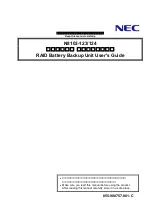
9.0113
11
Battery charger type BC120202, BC120263, BC120403, BC120603, BC120803, BC240303, BC240503, BC240803
ENGLISH
4.3
Polarity reversal protection
By wrongly connecting plus and minus of the battery, the charg-
ing current fuse will blow.
Insert a new fuse of the same type and ensure that it contacts
properly.
Always connect the plus (+) cable(s) first and the minus (-)
cable last.
4.4
Diode splitter
The battery charger is provided with a diode splitter so that sev-
eral batteries can be charged separately from one another.
Connect the light battery to connection B1 of the battery charg-
er.
For separate charging of the batteries with the dynamo a sepa-
rate diode splitter must be installed. Use the Vetus voltage loss
proof diodes splitter or ensure that the charging voltage of the
dynamo is compensated.
4.5
Selecting battery type
Set the battery charger for the type of lead/acid battery that has
to be charged.
1 Fluid filled batteries, both open and gastight batteries and
starting batteries, semi-traction batteries.
2 Gel filled batteries.
Refer to ‘10 Connection drawings’, this shows where the switch
is for setting the battery type.
4.6
LED control panel
Refer to ‘10 Connection drawings’ for connecting an optional
LED control panel.
4.7
Remote control panel
Refer to ‘10 Connection drawings’ for connecting an optional
remote control panel.
4.8
Temperature sensor
If in tropical climates or due to other conditions the batteries
become very hot, it is advisable to adjust the charging type for
these (high) battery temperatures. This is possible with the
temperature sensor, optionally available from VETUS.
Remove the 2 k ohm resistance and connect an optional tem-
perature sensor.
Refer to ‘10 Connection drawings’ for connecting an optional
temperature sensor.
Place the temperature sensor on the battery which will reach the
highest temperature.
N.B.
BC120202: It is not possible to connect a temperature
sensor to this battery charger.
BC240803: 2 temperature sensors must be connected
to this battery charger, 1 on the lower printed circuit
board and 1 on the top printed circuit board.
4.9
Connection to mains voltage
N.B.!
The battery charger must be set at the voltage at which
it is connected; 230 Volt / 50 Hz or 115 Volt / 60 Hz.
The battery charger is supplied ready for use at 230 Volt AC.
N.B.
Battery charger BC240803 is only suitable for 230 Volt
50 Hz.
Setting (or checking the setting) must always be carried out
before the battery charger is connected to the mains for the first
time.
An incorrect setting for the mains voltage (e.g. set-
ting at 115 Volt AC whereas the mains voltage is 220
Volt AC) will result in irreparable damage to the bat-
tery charger.
Amending setting
To amend the setting, move the cable socket as shown in the
drawings, see ‘10 Connection drawings’.
The apparatus must be protected against high touch voltage
according to instructions of the local electricity company.
The mains fuse to be used must be according to the table here
below:
Nominal current consumption
of battery charger
Mains fuse
0 – 6 A
6 A
6 – 10 A
10 A
10 – 16 A
16 A
16 – 20 A
20 A
gL fuses or safety automatics of type B or C can be used.
It is advisable to earth the battery charger to comply
with the CE guidelines.
Warning!
Earthing 230 Volt electrical apparatus on board of a ship that is
not connected via a quayside connection with a quay socket
protected against earth leakage is only worthwhile, if an earth
leakage protection or chassis insulation protection is present
(floating mains).
Consult your installer for this.
Additionally the local regulations that can differ per country are
of importance and also their application can be important (often
special rules apply for professional shipping and in particular
passenger ships).
VETUS can not accept responsibility for use of the battery
charger contrary to the local regulations.












































